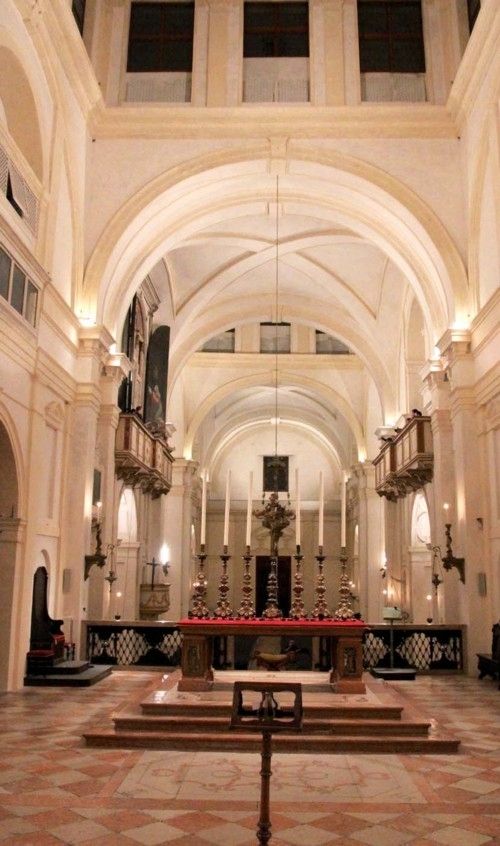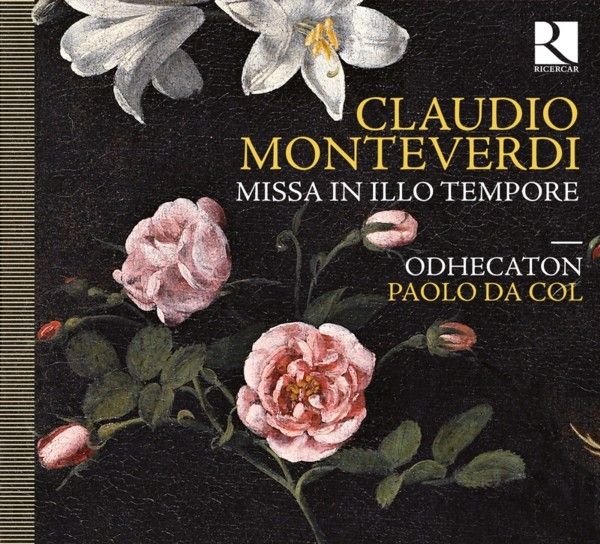
Ricercar 322
2012
Claudio MONTEVERDI (1567-1643)
Missa da capella a sei voci*,
fatta sopra il motetto In illo tempore del Gomberti, a 6
1. Kyrie* [3:53]
2. Gloria* [5:59]
3. Salve Regina [II], a 3 [3:59]
(TTB: VD, MBor, MBel)
4. Credo* [10:20]
5. Salve Regina [III], a 3 [4:23]
(TTB: RG, GF, MV)
6. Sanctus* [3:42]
7. Agnus Dei*, a 6 e 7 [5:16]
8. Regina caeli, a 3 [3:30]
(CCA: SF, BZ, GM)
9. Cantate Domino, a 6 [1:54]
Giaches DE WERT (1535- 1596)
10. Fantasia per organo [4:49]
11. Vox in Rama, a 5 [3:36]
12. Ascendente Jesu, a 6 [5:20]
(I pars: AC, SB, CC, GF, FF, DB)
13. Adesto dolori meo, a 6 [3:10]
Nicolas GOMBERT (c.1495-c.1560)
14. In illo tempore loquente Jesu, a 6 [4:45]
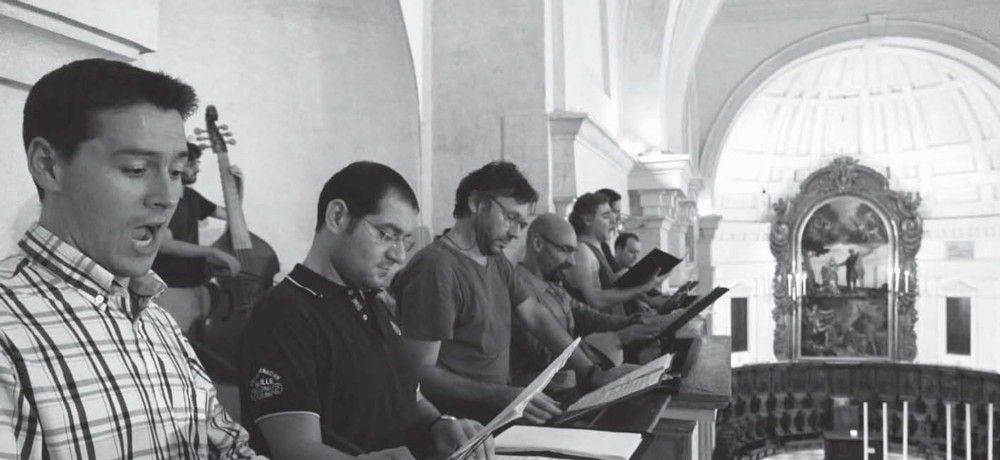
Odhecaton
Paolo Da Col
Alessandro Carmignani, Christophe Carré, Stephen Burrows,
Aurelio Schiavoni, Roberto Balconi, Gianluigi Ghiringhelli:
countertenors
Fabio Furnari, Gianluca Ferrarini, Paolo Fanciullacci, Massimo Altieri,
Vincenzo Di Donato, Raffaele Giordani: tenors
Mauro Borgioni: baritone
Matteo Bellotto, Davide Benetti, Marcello Vargetto: basses
Marta Graziolino: harp
Liuwe Tamminga: organ
Federico Bagnasco: violone
Massimo Sartori: bass viol
Michele Pasotti: theorbo
with the participation of
Silvia Frigato, Barbara Zanichelli: sopranos
Gabriella Martellacci: contralto
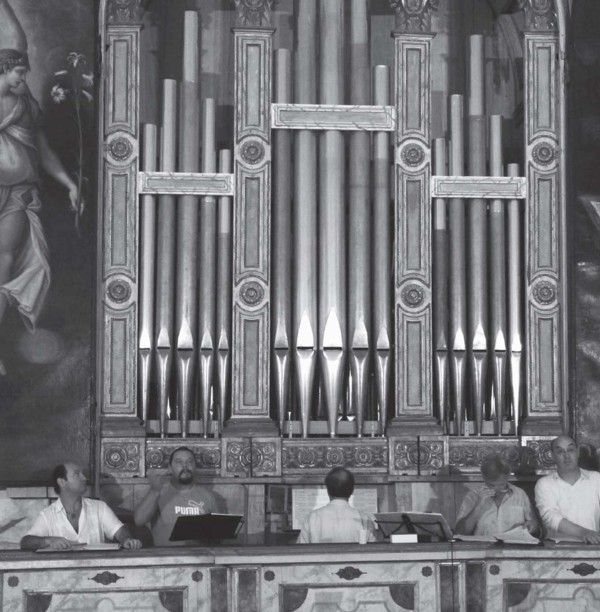
Recorded in September 2011: Mantova, Basilica di Santa Barbara
Artistic direction, recording & editing: Jérôme Lejeune
Sources
#1, 2, 4, 6, 7: Sanctissimae Virgini Missa senis vocibus ad
ecclesiarum choros ac Vesperae pluribus decantandae, Venezia,
Ricciardo Amadino, 1610 (edited by Melita Fontana, Bologna, Ut Orpheus,
2012)
# 3, 5, 8: Salve Regine del Sig. Claudio Monteverde [Venezia,
Alessandro Vincenti, 1662-1667] (edited by Luigi Collarile, Bologna,
Arnaldo Forni, 2011)
#9: Giulio Cesare Bianchi, Libro secondo de motetti in lode della
gloriosissima Vergine Maria Nostra Signora, Venezia, Alessandro
Vincenti, 1620
#10: Fantasia di Giaches, Roma, Biblioteca Vaticana, ms. Chigi
VIII 206
#11: Il secondo libro de motetti a cinque voci, Venezia, Erede
di Girolamo Scotto, 1581
#12: Modulationum cum sex vocibus liber primus, Venezia, Erede
di Girolamo Scotto, 1581
#13: Motectorum quinque vocum liber primus, Venezia, Claudio
Merulo e Fausto Betanio, 1566
#14: Motetti del frutto a
sei voci, Venezia, Antonio Gardano, 1539
(11-14: transcriptions by Renzo Bez)
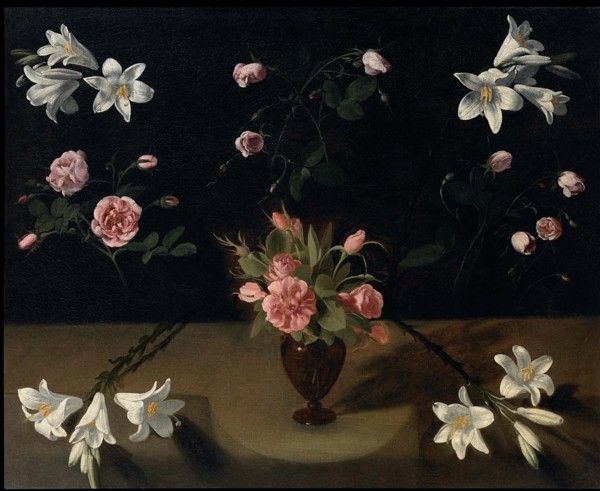
MUSIC AND DEVOTION AT THE
GONZAGA COURT: CLAUDIO MONTEVERDI AND GIACHES DE WERT
The lives of the two composers whose music makes up the major part of
this recording overlapped in the 1590s, when both were in the service
of the Gonzaga family in Mantua. Moreover, the music presented here was
almost certainly originally written for the same remarkable
institution, the Palatine Basilica of Santa Barbara, which had been
constructed over a ten-year period beginning in the late 1560s. This
recording was made inside this church, using not only the West gallery
(mentioned by contemporaries as being used by the musicians of the cappella),
but also the two cantorie which stand halfway down the nave, in
one of which is preserved the organ constructed by Costanzo Antegnati
in 1565. The Basilica had been planned from the start as a kind of
dynastic temple, a theatre for Gonzaga politico-dynastic ceremonies, as
well as a highly individual interpretation of Catholic reformist
attitudes towards sacred art. Its special character, expressed through
extraordinary papal privileges, which included permission to draw up
its own rite, and the provision of prestigious positions for its
clergy, automatically conferred upon Santa Barbara a status which made
it the envy of other Italian princes. The role of the Duke of Mantua,
Guglielmo Gonzaga, a pious and careful ruler keen to project an image
of himself as the True Christian Prince, was central to this
development; the construction and operations of the Basilica, and
especially the evolution and performance of its substantial musical
repertory (conserved virtually complete in the Conservatory in Milan),
occupied him almost to the point of obsession.
Giaches de Wert, who was born in Flanders, arrived in Mantua to take up
the post of maestro di cappella of Guglielmo Gonzaga’s
new Basilica in 1565, and he was to remain there until his death some
decades later. Although much of his time in Mantua was occupied with
writing madrigals (he was to publish no fewer than eight books in the
genre during these years), his main duties as maestro required
him to be in charge of the composition and performance of liturgical
music. Nonetheless, he composed only a modest amount of sacred works
himself, including just three published books of motets, two for five
voices and the third one for six. The high point of the second book of
1581 is undoubtedly Vox in Rama, a setting of a text taken from
the Book of Jeremiah which is also quoted in St. Matthew’s
Gospel. This describes, in plangent and moving language, the sense of
desolation experienced by a mother over the loss of her children. It
begins with a stark opening motif in the low tessitura of each voice,
followed by a dramatic rising octave leap. This sets the tone for the
rest of the piece, which exploits to the full many techniques that are
more characteristic of Wert’s madrigals. Equally dramatic is Ascendente
Jesu, which first appeared in the Modulationum cum sex vocibus
liber primus, also published in 1581. As Wert himself acknowledged
in a letter of March 1579, this presents considerable difficulties for
the singers at the words ‘ecce motus magnus factus est in
mari, ita ut navicula operiretur fluctibus’, words which
prompted him to respond with an extended passage full of syncopations
and cross rhythms which occur in different voices at different times.
In what is an extremely rare example of a contemporary comment by a
composer about his own music, Wert makes a plea for artistic licence;
should all not go well, he writes, it is the fault of the performers
and not the composer. More restrained in style is Adesto dolori meo,
printed in 1566, and conceivably composed before Wert took up his post
in Mantua. Largely through Gonzaga influence, he had previously served
the Spanish Governor in Milan (where members of the Gonzaga held
powerful military positions), and before that the Gonzaga of Novellara,
a cadet branch of the family which governed a small court located in
the Po valley. In other words, Wert was a good company man whose
fortunes were inextricably linked to Gonzaga patronage. This provided
him with stability and employment throughout his entire career, from
his arrival in Novellara in about 1551 until his death in Mantua in
1596.
Claudio Monteverdi’s relations to the Gonzaga were more
complicated. From Cremona, where he had been born in 1567, Monteverdi
arrived in Mantua in about 1590, initially to take up service as an
instrumentalist at court. Despite his steady output of madrigals, not
to mention the composition of L’Orfeo, L’Arianna,
and the Ballo dell’Ingrate for performance at court in
1607-8, he was never appointed as maestro at Santa Barbara, and when
the post fell vacant in 1609, Monteverdi was passed over. That may have
been partly due to his profile as a composer. It was now some
twenty-seven years since he had published any sacred music, and even
that, the juvenile Sacrae cantiunculae of 1582, written during
his apprenticeship in Cremona, does not include any settings of
liturgical texts. It might well have been this lacuna that now prompted
him to embark on an ambitious and unusual plan to publish the
large-scale collection of fifteen pieces which has come to be known as
the Mass and Vespers of 1610. The two liturgical halves of this
publication are also stylistically contrasted. Whereas the Vespers
music includes a number of solo motets in the latest virtuoso song
style, the Mass setting is altogether more conservative in style, and
was perhaps Monteverdi’s response to the attacks that had
recently been launched upon his music by the Bolognese theorist,
Giovanni Maria Artusi, the last of which had appeared in print only two
years previously. Certainly the Mass sets out to demonstrate
Monteverdi’s complete technical mastery of the prima prattica
manner, being cast in a dense, imitative texture based on motifs taken
from the motet In illo tempore composed by the Flemish composer
Nicolas Gombert more than seventy years earlier. Artusi apart, the
decision to adopt the prima prattica manner is not that
uncommon among contemporary composers, notwithstanding the discernible
shift to the concertato style in North Italian church music.
Since the greater part of the liturgical texts of the Mass are
essentially neutral in character, the older style possessed both the
capacity to render these effectively as well as evoking the hallowed
status of tradition. Another feature of Monteverdi’s choice may
well have been the influence of his teacher Marc’Antonio
Ingegneri (with whom he had studied in Cremona in the 1580s), whose
music largely avoids the recent homophonic style advanced by Andrea
Gabrieli and other members of the Venetian school, in preference for
flowing polyphony.
Since, as the title-page declares, both Vespers and Mass are addressed
not only to the Virgin but also to Pope Paul V, the entire publication
effectively carries a double dedication. In the case of the Virgin this
was appropriate not only as a response to the notable increase in
Marian devotion characteristic of the period, but also because Mary was
venerated as a protector and patroness of both the city of Mantua and
of its rulers. On the other hand, the more immediate relevance of the
Papal dedication becomes clear from Monteverdi’s subsequent
actions. Later in the same year the composer travelled to Rome to
present a copy of the Mass and Vespers to the Pope, partly it seems in
the hope (which in the event turned out to be in vain), of obtaining a
place in the Seminario Romano for his son, Francesco. Conscious
perhaps of his deteriorating relationship with the Gonzaga (his letters
from these years are shot through with complaints of hardship and
overwork), it may be that Monteverdi was also laying the groundwork for
an attempt to find a post in Rome itself, by demonstrating his complete
mastery of the whole range of current styles of sacred music, including
Netherlandish polyphony.
Although the Missa In illo tempore is one of just three
complete settings by Monteverdi that are known, he must have composed
many more if we are to believe his statement, made in a letter of
February 1634, that he was required to write a new setting of the
Ordinary every year for performance in St. Mark’s Basilica on
Christmas Eve. The other two surviving settings, both of which were
probably written during his Venetian years, also rely upon the
restrained a cappella style of the second half of the sixteenth
century which, by the time that they were written, had become known as
the stile antico (the old style). In effect, all three of
Monteverdi’s masses are highly wrought exercises in a form of
conscious antiquarianism that not only demonstrate Monteverdi’s
command of traditional techniques, but also stand in stark contrast to
much of the church music that was then being written, including much of
that composed by Monteverdi himself. The 1610 Mass quite consciously
recalls an even more archaic contrapuntal language; shaped by the
motifs taken from Gombert’s motet, which are frequently given
prominence, it displays the rigid adherence to a tautly-constructed
imitative texture that is characteristic of many works of the
post-Josquin generation. In pursuit of this goal Monteverdi has
recourse to an armoury of contrapuntal complexities, including
paraphrase, countersubjects, invertible counterpoint, inversion,
retrogression, augmentation, and canon. Prominent too is the use of
sequence, which recalls the music of Josquin himself, who deployed the
technique to great effect in the search for symmetry, as in the Missa
L’homme armé sexti toni. This device produces some of
the clearest moments of articulation in Monteverdi’s mass. The
relentless imitative texture is relieved by homophony on just two
occasions, with the Et incarnatus est section of the Credo, and
throughout the Benedictus. Both of these begin on a bright E major
triad, in distinct contrast to the long surrounding passages in the
Ionian mode (in which most of the Mass is written), with the effect of
expressively illuminating the concept of the Incarnation itself.
Despite (or perhaps because of) its radically conservative character,
the Missa In illo tempore was still being performed in the
Sistine Chapel as late as the eighteenth century.
A high point of the present recording is the inclusion of three
previously unknown works by Monteverdi, recently identified by the
Italian musicologist Luigi Collarile. Two of these are settings of the
Marian antiphon Salve Regina, while a third takes as its text
the Easter antiphon Regina Caeli. All three, which are scored
for different combinations of three voices with organ accompaniment,
have lain unnoticed (though to some extent disguised) in the only
surviving copy of a collection of sacred music printed by the Venetian
printer Alessandro Vincenti in the 1660s, some twenty years after
Monteverdi’s death. It may well have been Francesco Monteverdi
who was responsible for arranging the publication of his father’s
music by Vincenti, who also printed a number of other posthumous works
during the 1650s. Such pieces were multi-purpose, since they could have
been performed by Monteverdi and three singers on any Marian feast in
the Church year. There can be little doubt about the authenticity of
these three new identifications – all three pieces demonstrate
Monteverdian fingerprints on every page. Highly characteristic uses of
affective chromaticism, staccato dotted rhythms and declamatory
passages, and the oscillation between duple and triple time are just
three of the elements that speak eloquently of Monteverdi’s
authorship. The inclusion of all three, recorded here for the first
time, is testimony to the happy marriage of scholarship and practical
musicianship that is characteristic of the work of Odhecaton.
IAIN FENLON
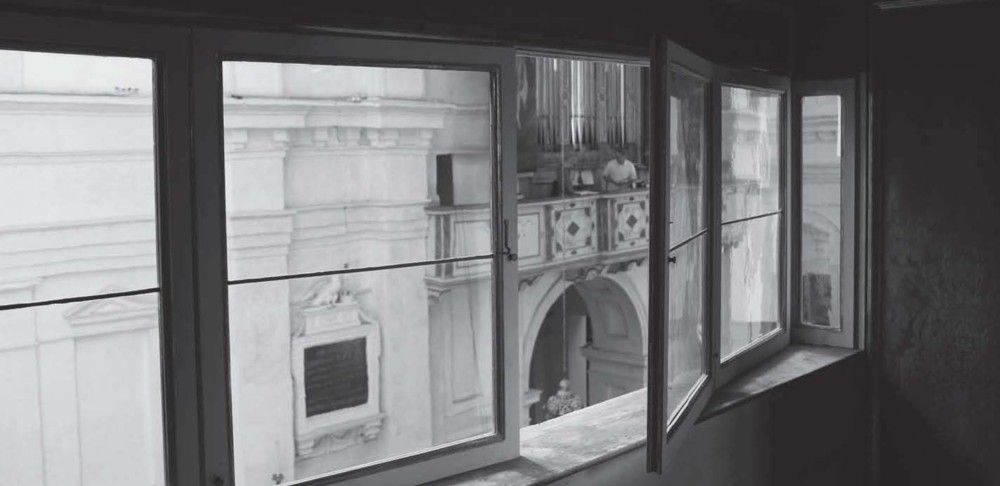
Sur les pas de Monteverdi
Réaliser un enregistrement dans ce lieu mythique fut pour moi
à la fois un moment émouvant et un instant de
réflexion – voire de doute – sur tous les principes
de base de la prise de son. L’émotion d’abord.
Même si Monteverdi ne fut pas responsable de la musique de la
chapelle au service du duc de Gonzague (il y fut engagé
d’abord comme violiste), on ne peut douter qu’il n’a
pas, au titre de compositeur, ou à celui
d’interprète, participé à la musique des
offices de la chapelle. Certaines de ses plus importantes compositions
religieuses (dont celles du recueil de 1610) ont été
écrites durant sa période mantouane. Il est donc probable
que c’est dans cet édifi ce que quelques-uns de ses
chefs-d’œuvre ont résonné pour la
première fois. Et, en les écrivant, pensait-il à
la disposition des différentes tribunes?
L’escalier qui conduit à la tribune de gauche, celle qui
fait face à la tribune d’orgue, est celui que les pieds de
Monteverdi ont foulé il y a plus de quatre siècles.
Marcher dans ses pas fut pour moi d'une émotion incroyable. Ma
réflexion sur le son fut immédiate. Ne fallait-il pas
aussi dans l’enregistrement qui allait être
réalisé tenter de retrouver le miracle sonore de la
basilique avec ses qualités propres, ses particularités?
Or, il se fait que le volume sonore de l’édifi ce est
très ample, la réverbération, sans être trop
grande, est malgré tout importante. Devais-je me mettre à
la place de l’auditeur du XXIe siècle, confortablement
installé devant sa chaîne hi-fi et épiant tous les
détails de la partition? Ou, au contraire, fallait-il
m’imaginer à la place du duc et de ses proches dans la
petite loge qui se trouve à gauche du chœur, ou tout
simplement au centre de l’église, là d
’où l’on peut entendre la musique venant des deux
tribunes latérales de la nef centrale, ou de la grande cantorie
du fond de l’église, elle-même flanquée de
deux tribunes latérales?
Lorsque l’on est au centre de l’église, le son qui
provient des diverses tribunes est très ample; il
bénéficie de la réverbération du lieu, mais
transmet tous les détails avec une incroyable précision.
Hélas!, nos micros n’ont pas l’intelligence de nos
oreilles. Mais, les conditions exceptionnelles du lieu m’ont
convaincu qu’il ne fallait pas vouloir reproduire le son
standardisé de bon nombre d’enregistrements où
l’on cherche à la fois la proximité et ce
qu’il faut d’ambiance générale pour faire
fusionner tous les timbres des instruments et des chanteurs et
reconstituer plus ou moins l’acoustique du lieu.
Il eût été simple de mettre tous les musiciens au
centre de l’église ou dans le chœur, de trouver une
disposition optimale pour satisfaire à une implantation de
micros classique et obtenir un son qui corresponde aux habitudes
actuelles. Mais, ici, la disposition dans les lieux
«originaux» a imposé des choix différents.
Utilisant l’orgue Antegnati (celui que Monteverdi a entendu), la Missa
in illo tempore et le motet Cantate Domino ont
été enregistrés depuis les deux tribunes de la nef
centrale. L’idée de départ était de mettre
tous les chanteurs dans la tribune qui fait face à
l’orgue. D’une part ils y étaient un peu à
l’étroit et d’autre part le son semblait
collé contre le mur. L’idée fut alors de
répartir les chanteurs entre les deux tribunes. Quelle ne fut
pas la surprise de se rendre compte que d’une tribune à
l’autre les chanteurs s’entendaient parfaitement et
pouvaient chanter ensemble sans être perturbés par le
moindre retard venant des chantres de la tribune opposée! La
portion de voûte qui relie les deux tribunes avait
été évidemment pensée pour que la
transmission du son soit optimale entre elles.
Du coup, pour ce qui était de l’enregistrement, les micros
placés au centre de la nef donnaient une image sonore pleine,
équilibrée et finalement assez précise. La
répartition des voix apparaît clairement à
l’audition (ce que l’on peut aisément percevoir par
exemple avec les deux voix de dessus réparties entre les deux
tribunes). Alors que dans l’église, la harpe et le violone
qui se trouvaient dans la petite alcôve derrière les
chanteurs de la tribune de gauche étaient très nettement
perceptibles, il fut nécessaire de leur donner un petit micro
d’appoint.
La cantorie du fond de l’église fut
utilisée pour les trois motets inédits avec basse
continue et pour les motets a capella sans orgue. Cette tribune est
beaucoup plus spacieuse que les tribunes étroites de la nef.
Elle permet plus facilement la disposition de chanteurs et
d’instruments. On y imagine assez facilement le lieu pour les
pièces les plus développées, telles la Sonata
des Vespro, supposant que le cantus firmus viendrait de
l’une des tribunes de la nef! Ici, il a fallu trouver une
association entre des micros qui assuraient une certaine
précision de la perception des chanteurs et des instruments et
d’autres qui restituaient l’acoustique du lieu, a fin de
retrouver ce miracle que l’on découvre, installé
quasi n’importe où dans l’église.
JÉRÔME LEJEUNE
